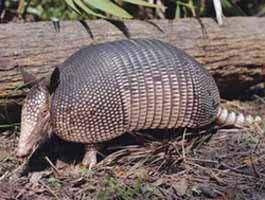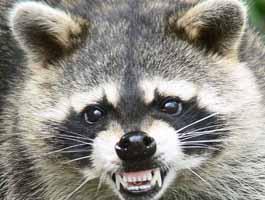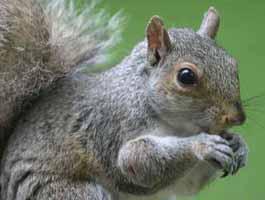
Armadillo
The nine-banded armadillo (Dasypus novemcinctus), named for the nine breaks in the creature’s leathery armor that allow it to flex its stiff hide, is an odd-looking mammal about the size of a cat. Armadillos are not native to Florida, but are now common over most of the state. Armadillos like forested or semi-open habitats with loose textured soil that allows them to dig easily. They eat many insects, or other invertebrates, and some plants. They most often feed at night, and have very poor eyesight.
Armadillos dig burrows for homes or to escape predators, and a single armadillo can have several different burrows with multiple entrances. A mature armadillo is 15 to 17 inches long (not counting the tail) with a weight of eight to 17 pounds. Pregnant females always give birth to identical quadruplets. She produces one egg that splits into four identical offspring that are either all female or all male. This trait differs from most other mammals.
Armadillos are fascinating in other respects. When they need to cross narrow water bodies, they often walk on the bottom under water. If it is a wide body of water, they will inflate their stomach to twice its normal size, allowing for enough buoyancy to swim across. When startled, armadillos often leap high into the air, and then run quickly to a nearby burrow.
Armadillos prolific rooting and burrowing can severely damage lawns and flower-beds. To reduce armadillo damage to your lawn keep watering and fertilization to a minimum. Moist soil and lush vegetation bring earth worms and insect larvae (armadillo candy!) to the surface of the soil.
The nine-banded armadillo (Dasypus novemcinctus), named for the nine breaks in the creature’s leathery armor that allow it to flex its stiff hide, is an odd-looking mammal about the size of a cat. Armadillos are not native to Florida, but are now common over most of the state. Armadillos like forested or semi-open habitats with loose textured soil that allows them to dig easily. They eat many insects, or other invertebrates, and some plants. They most often feed at night, and have very poor eyesight.
Armadillos dig burrows for homes or to escape predators, and a single armadillo can have several different burrows with multiple entrances. A mature armadillo is 15 to 17 inches long (not counting the tail) with a weight of eight to 17 pounds. Pregnant females always give birth to identical quadruplets. She produces one egg that splits into four identical offspring that are either all female or all male. This trait differs from most other mammals.
Armadillos are fascinating in other respects. When they need to cross narrow water bodies, they often walk on the bottom under water. If it is a wide body of water, they will inflate their stomach to twice its normal size, allowing for enough buoyancy to swim across. When startled, armadillos often leap high into the air, and then run quickly to a nearby burrow.
Armadillos prolific rooting and burrowing can severely damage lawns and flower-beds. To reduce armadillo damage to your lawn keep watering and fertilization to a minimum. Moist soil and lush vegetation bring earth worms and insect larvae (armadillo candy!) to the surface of the soil.


Opossum
Florida's only marsupial (a mammal of the order Marsupialia having a pouch containing the mammary glands and serving as a receptacle for the young) is the Virginia opossum (Didelphis virginiana). Opossums are about the size of a house cat, have long naked tails and small ears. Opossums occur throughout the state in virtually all habitats. If threatened they may go limp and appear dead, hence "playing possum". Opossums are common in residential and suburban areas, and are most active at night.
Opossums are attracted to virtually any type of available food, including garbage, pet food, or cultivated fruits and vegetables.
Florida's only marsupial (a mammal of the order Marsupialia having a pouch containing the mammary glands and serving as a receptacle for the young) is the Virginia opossum (Didelphis virginiana). Opossums are about the size of a house cat, have long naked tails and small ears. Opossums occur throughout the state in virtually all habitats. If threatened they may go limp and appear dead, hence "playing possum". Opossums are common in residential and suburban areas, and are most active at night.
Opossums are attracted to virtually any type of available food, including garbage, pet food, or cultivated fruits and vegetables.

Raccoon
The raccoon (Procyon lotor) is about the size of a small dog, and is most notable for its black mask and bushy ringed tail. Raccoons are common throughout the state and occur everywhere there are trees, the cavities of which they often use. Raccoons are omnivorous feeding on fruits, plant material, eggs, crustaceans, small animals, and garbage. Raccoons usually become active in the late afternoon and throughout the night.
Wild raccoons that lose their natural fear of humans seek to move closer to their food source--your house. Once raccoons take up residence in your attic or outbuildings they can become very destructive and difficult to remove.
Prevention is the key to dealing with raccoon problems. Do not feed raccoons! Do what you can to eliminate their artificial food sources. Bring in pet food at night and secure trash cans by either fastening the lid tightly or enclosing them in lockable bins. Make sure bird feeders are not accessible to raccoons (i.e., squirrel-proofed).
Raccoons should not be handled by inexperienced individuals because of the risk of rabies infection.
The raccoon (Procyon lotor) is about the size of a small dog, and is most notable for its black mask and bushy ringed tail. Raccoons are common throughout the state and occur everywhere there are trees, the cavities of which they often use. Raccoons are omnivorous feeding on fruits, plant material, eggs, crustaceans, small animals, and garbage. Raccoons usually become active in the late afternoon and throughout the night.
Wild raccoons that lose their natural fear of humans seek to move closer to their food source--your house. Once raccoons take up residence in your attic or outbuildings they can become very destructive and difficult to remove.
Prevention is the key to dealing with raccoon problems. Do not feed raccoons! Do what you can to eliminate their artificial food sources. Bring in pet food at night and secure trash cans by either fastening the lid tightly or enclosing them in lockable bins. Make sure bird feeders are not accessible to raccoons (i.e., squirrel-proofed).
Raccoons should not be handled by inexperienced individuals because of the risk of rabies infection.

Squirrel
Florida is home to three species of squirrels, the eastern gray squirrel (Sciurus carlinensis), the fox squirrel (Sciurus niger), and the southern flying squirrel (Glaucomys volans). The most common in urban areas is the eastern gray squirrel (pictured here). Squirrels occur in woodland and urban areas, especially near oaks and hickories, and are active during the day, often feeding on the ground.
During late summer squirrels may be seen rolling on the ground, biting themselves, and jumping up and down. This is usually due to skin irritations from bot fly larvae, which are parasites that appear as bumps on the skin, often in places where the squirrel cannot scratch. The parasite is located only in the skin and does not affect edibility of the meat in harvested squirrels.
Squirrels can cause problems by chewing on plants, tree bark and ornamentals as well as plastic items, like electrical wiring insulation or even wood siding on houses and out-buildings. It is often impossible or impractical to eliminate the source of their chewing.
Florida is home to three species of squirrels, the eastern gray squirrel (Sciurus carlinensis), the fox squirrel (Sciurus niger), and the southern flying squirrel (Glaucomys volans). The most common in urban areas is the eastern gray squirrel (pictured here). Squirrels occur in woodland and urban areas, especially near oaks and hickories, and are active during the day, often feeding on the ground.
During late summer squirrels may be seen rolling on the ground, biting themselves, and jumping up and down. This is usually due to skin irritations from bot fly larvae, which are parasites that appear as bumps on the skin, often in places where the squirrel cannot scratch. The parasite is located only in the skin and does not affect edibility of the meat in harvested squirrels.
Squirrels can cause problems by chewing on plants, tree bark and ornamentals as well as plastic items, like electrical wiring insulation or even wood siding on houses and out-buildings. It is often impossible or impractical to eliminate the source of their chewing.
Most Common Nuisance Animals
Roof Rat
The roof rat ( Rattus rattus , a.k.a. citrus rat, fruit rat, black rat, or gray rat) is an introduced species of rat native to southern Asia. It was brought to America on the first ships to reach the New World and has spread around the world. This rat is the same species that carried the bubonic plague around the world and is also the reservoir host for murine typhus. Roof rats are the worst rodent pest in the state of Florida and most abundant. The Norway rat ( Rattus norvegicus ) that is familiar to most people is rare in Florida.
Roof rats consume and destroy stored animal and human food, attack fruit crops, and take up residence in attics, soffits, hollow walls, and out-buildings. When they invade buildings they chew through wires (potentially starting fires), gnaw through plastic and lead water pipes, make holes in walls and cause other structural damage.
The roof rat ( Rattus rattus , a.k.a. citrus rat, fruit rat, black rat, or gray rat) is an introduced species of rat native to southern Asia. It was brought to America on the first ships to reach the New World and has spread around the world. This rat is the same species that carried the bubonic plague around the world and is also the reservoir host for murine typhus. Roof rats are the worst rodent pest in the state of Florida and most abundant. The Norway rat ( Rattus norvegicus ) that is familiar to most people is rare in Florida.
Roof rats consume and destroy stored animal and human food, attack fruit crops, and take up residence in attics, soffits, hollow walls, and out-buildings. When they invade buildings they chew through wires (potentially starting fires), gnaw through plastic and lead water pipes, make holes in walls and cause other structural damage.
Adult roof rats are 12-14 inches long (30-36cm) and weigh 5-10oz. (150-250g). The tail of a roof rat is longer than the head and body length: hairless, scaly, and black color. The body is sleek and graceful with prominent ears and eyes. There are three color phases seen in Florida: black back with a slate gray belly, gray back with lighter gray belly, and brownish gray above with a white or cream colored belly.
In addition to the damage done to fruit, other evidence includes black banana-shaped droppings about 1/4-1/2 inch long (about 1 cm) and dark smears or rub marks seen along the rat's travel routes.
In addition to the damage done to fruit, other evidence includes black banana-shaped droppings about 1/4-1/2 inch long (about 1 cm) and dark smears or rub marks seen along the rat's travel routes.
FOR SERVICE AND INFO (727) 248.0055
(727) 248.0055

Animal Removal Company © 2018

727-248-0055











